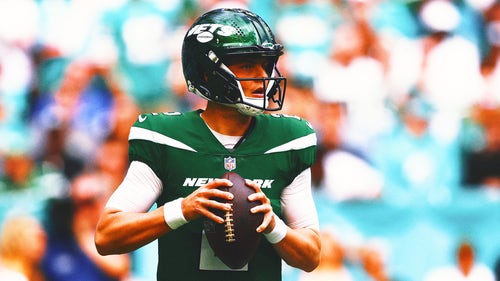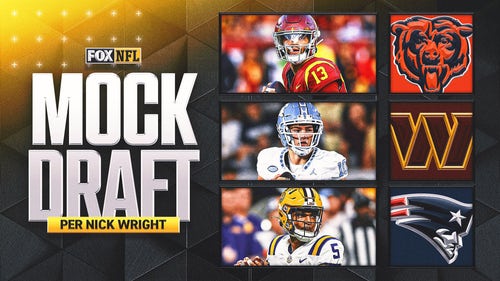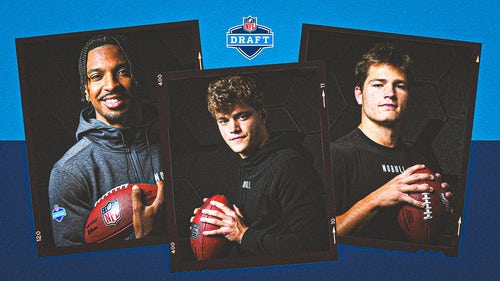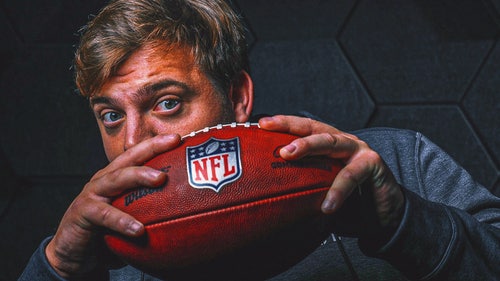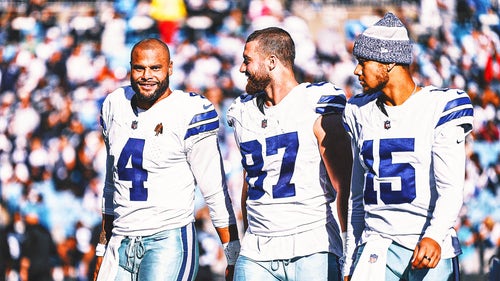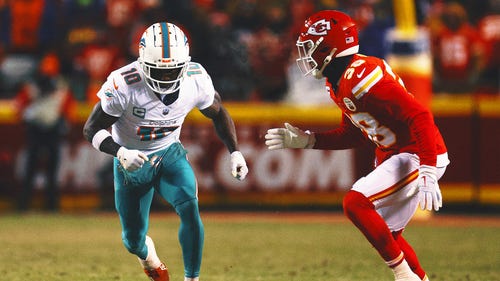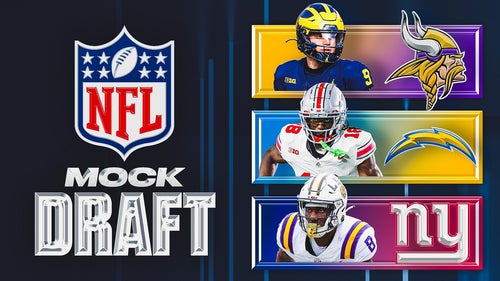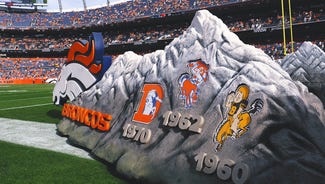
Medical questions hurt Taylor's stock
When reports leaked last week that a team had altogether removed Baylor 340-pound defensive tackle Phil Taylor from its draft board, I nodded my head, shrugged my shoulders and added the big fella’s name to a rather exclusive list.
Taylor, who’s rumored to have a debilitating foot injury that’s reportedly “not correctable” through surgery, is joined by Clemson defensive end Da’Quan Bowers as this year’s two inductees to the “Hall of Red Cross,” a swanky club consisting of each NFL draft’s biggest medical question marks.
Whether through actual physical examination or mere misinformation, there are usually at least two top draft prospects whose respective draft stock suffered because of injury concerns in the final days leading up to draft weekend.
One exception could be the 2010 draft, with Sam Bradford and Jermaine Gresham breaking this trend (as I'll explain later).
Taylor’s foot injury could knock him from being a potential mid-first-round selection into becoming a mid-to-late-second-round pick, while Bowers’ lingering knee issues could cost him several million dollars.
Bowers, who as recently as February was thought to be in the running for the Carolina Panthers’ top overall selection, has been attached to teams in the mid-20s because of recent medical concerns. Late last week, in a rather curious move, Bowers’ agent Joe Flanagan emailed ESPN for the second time since the NFL Scouting Combine, trying to put a Band-Aid on his client’s bleeding draft stock. Flanagan’s email said the following:
"As to his progress and the feedback from the medical recheck, every team we've spoken to, including multiple GMs, has said that, overall, Da'Quan's knee has shown good healing. [The knee] has continued to get better since the Combine, and, perhaps most importantly, showed absolutely no acute or remote ill-effects as a result of his April 1 workout."
Flanagan also stated that Bowers' knee did not swell after the Combine workout or after a series of flights — which also can increase swelling.
The email closed with: "Bottom line: if it's holding up from a pounding in April, it should clearly hold up in August."
Whereas Flanagan is doing all he can to salvage his client’s bill of health, there’s been little word from the Taylor camp on the Baylor big man’s medical red flags. Sometimes, the media just course corrects itself. Citing a league source with “knowledge of the situation,” the National Football Post refuted the report on Taylor’s plummeting draft stock, indicating that the source “chalks up the original report to typical draft rumor shenanigans, with teams hoping Taylor will fall to them.”
So, what’s real? What’s not? It’s the beauty of the final days leading up to the draft. Smoke screens are shot from every which way, and it’s each team’s (and member of the media’s) job to best sort out what’s legit and what’s hooey.
Bowers and Taylor aren’t the first draft prospects to go through this grueling “medical red flags” process, though. In 2008, Virginia offensive tackle Eugene Monroe was rumored to be going as high as second overall to St. Louis. Then, in the weeks leading up to the draft, concerns over knee injuries he suffered during his sophomore and junior seasons began creeping up.
“In college, I had a knee injury during my first year,” Monroe told me earlier this week from his home in Jacksonville. “I recovered from the injury, played very well over the next two seasons, and didn’t miss a start my senior year. I, then, went to the Combine and performed at a really high level there.”
Then came the doctors.
“A few weeks before the draft, I started hearing that teams were shying away from me because of the knee injury I suffered two years earlier. At the Combine, they do all these physicals and tests, and I guess some junk from the injury showed up in X-rays. My take at the time was, ‘Everybody gets hurt playing football. Some guys have twelve surgeries and still play at a high level. It never impacted my performance as a player.’ I played better after the injury.”
He eventually was picked eighth overall by Jacksonville, where he’s been the team’s starting left tackle since he showed up to training camp his rookie year. “If anyone had any questions about my abilities as a player, all they had to do was watch my game film,” Monroe said. “An MRI can’t tell you everything about a player. I’ve been in the league for three years now. I haven’t missed a single snap because of my knee.”
Monroe empathizes with both Taylor and Bowers. His advice for them? “Don’t let it get to you too much. Everything happens for a reason. Just come ready to perform starting on day one, wherever you end up.”
As both young men prepare for what will be a grueling next few days, they have guys like Monroe to look toward. Here are their fellow “Hall of Red Cross” members from the past four drafts.
As you’ll see, in most cases, the players with the biggest medical concerns haven’t been all that hampered by injuries in the pros, after all.
2007
1. Adrian Peterson, RB, Oklahoma
Projected draft spot: top five
Eventual draft spot: No. 7 overall to Minnesota
The situation: Peterson broke his collarbone in an October 2006 game against Iowa State and missed the rest of Oklahoma's regular season, returning for the team’s bowl game against Boise State. Peterson made NFL teams aware of a reinjury at the Combine in February 2007, but there was concern he’d need a surgery that’d keep him sidelined throughout training camp. He didn’t. Instead, he ran for 1,341 yards and 12 touchdowns in his rookie season.
2. Paul Posluszny, LB, Penn State:
Projected draft spot: top 15
Eventual draft spot: No. 34 overall to Buffalo
The situation: Posluszny was a two-time All-American at Penn State and won the Butkus Award in 2005 as a junior. He suffered a devastating knee injury in a 2006 Orange Bowl win. Though he recovered and excelled as a senior and showed no ill effects from the injury, he slipped to the second round. Four years later, he’s the Bills’ defensive team captain and a starting linebacker.
3. Alan Branch, DT, Michigan:
Projected draft spot: top 10
Eventual draft spot: No. 33 overall to Arizona
The situation: Branch’s epic slide from being considered a surefire top-10 prospect to going 33rd overall is among the draft’s most notable falls in recent years. Branch’s stock plummeted after it was revealed that he had two stress fractures in his lower legs that could impact the length of his NFL career. Branch only played in fifteen games over the first two years of his career, but he hasn’t missed a game in the past two.
2008
1. Glenn Dorsey, DT, Louisiana State
Projected draft spot: top three
Eventual draft spot: No. 4 overall to Kansas City
The situation: Though he was thought to be one of the top defensive lineman to enter the draft in quite some time, there were lingering concerns about Dorsey’s fractured tibia from his senior year at LSU. He still went fourth overall to Kansas City, where he has not lived up to expectations.
2. Jonathan Stewart, RB, Carolina
Projected draft spot: top 10
Eventual draft spot: No. 13 overall to Carolina
The situation: Stewart opted to undergo surgery on his foot in March, leaving him in a walking boot for many of his pre-draft visits. Before his surgery, some league insiders thought Stewart could go as high as No. 6 to the Jets. He went 13th overall to Carolina and had a tremendous rookie season, splitting carries with 2006 first-round pick DeAngelo Williams. Stewart followed that up in 2009 with 1,133 yards and 10 rushing touchdowns. His foot's been fine.
3. Marcus Harrison, DT, Arkansas
Projected draft spot: top 50
Eventual draft spot: No. 90 overall to Chicago
The situation: Harrison had first-round skills, but a knee injury straddled him with medical red flags heading into the 2008 draft. He slipped to the third round and, in three years with the Bears, he hasn’t done much.
2009
1. Eugene Monroe, OT, Virginia
Projected draft spot: top five
Eventual draft spot: No. 8 overall to Jacksonville
The situation: Monroe, who at one point was rumored to be going as high as No. 2 overall to St. Louis, fell to eighth after concerns over an old knee injury crept up in the weeks leading up to the draft. He hasn’t missed a game because of a knee injury in two years as an NFL starter.
2. Jasper Brinkley, LB, South Carolina
Projected draft spot: second to third round
Eventual draft spot: No. 150 overall to Minnesota
The situation: Brinkley was widely considered the top middle linebacker in college football before a devastating knee injury sidelined him for the 2007 season. He bounced back in 2008 and played solid football for the Gamecocks, but he was straddled with the dreaded medical red flag. He fell to the fifth round of the ’09 draft, found himself in the Vikings starting lineup after starter E.J. Henderson went down with an injury in 2009 and hasn’t missed a game in two years as a pro. His time is coming.
2010
1. Sam Bradford, QB, Oklahoma
Projected draft spot: top five
Eventual draft spot: No. 1 overall to St. Louis
The situation: Bradford suffered multiple shoulder injuries during his junior season, but appeared fully recovered in pre-draft workouts, throwing the ball harder and tighter than he had even prior to the injury. After passing on quarterbacks with top-five picks in consecutive years, the Rams grabbed Bradford first overall. He won the NFL’s Offensive Rookie of the Year award and started all 16 games.
2. Jermaine Gresham
Projected draft spot: first round
Eventual draft spot: No. 21 overall to Cincinnati
The situation: Gresham suffered a knee injury that caused him to miss the entire '09 season at Oklahoma. The Bengals worked him out, felt comfortable with his recovery, and he made an immediate impact as a rookie in 2010.
3. Rob Gronkowski
Projected draft spot: first or second round
Eventual draft spot: No. 42 overall to New England
The situation: Like Gresham, Gronkowski missed the entire ’09 season with an injury. He was an integral part to the Patriots’ aerial attack in 2010. No injury issues, either.
Both Bowers and Taylor could be destined for big NFL futures.
And though they’d rather not be, they’re already members of a pretty elite club.
Remember when: Forgotten moments in NFL draft history
Let’s re-examine the Cleveland Browns’ decision to select Tim Couch over quarterback Donovan McNabb in 1999.
Again, as was the case with both Dyson-over-Moss and Carmazzi-over-Brady, it’s easy to criticize the Browns for the Couch selection 12 years after the fact. Clearly, Couch wasn’t the player the Browns front office hoped he would be when they made the Kentucky gunslinger the reinvented franchise’s first-ever draft selection. But Dwight Clark, Carmen Policy, Chris Palmer and the rest of the Browns’ brain trust at the time weren’t the only ones excited by Couch’s boundless potential as an NFL quarterback in 1999.
NFL writer Mike Freeman, then writing for The New York Times, wrote in a pre-draft profile on Couch, “He stands out the way lobster distinguishes itself from a quarter-pounder. Nothing against the other passers available, but few of them can run an offense the way Couch does. Couch has something that is difficult to teach: an ability to feel a football game, a talent that many quarterbacks spend years trying to develop.”
Peter King wrote the following about Couch for a Sports Illustrated cover story that year: "Couch, however, has had too much success under pressure and showed too many signs of greatness at Kentucky to pass him over."
Amazingly, the pre-draft debate in Cleveland wasn’t even over Couch and McNabb. It was actually Couch and the eventual third overall pick by the Cincinnati Bengals, Akili Smith of Oregon. Compared to Smith, Couch’s six-year NFL career was worthy of Hall of Fame consideration. Compared to McNabb’s, it was a disaster.
Though he was a three-time Big East Player of the Year with dazzling numbers and a 35-14 record as a four-year starter at Syracuse, McNabb didn’t show his real abilities as a pocket passer until the Senior Bowl that January. There, he excelled. NFL scouts began viewing him as more than merely a glorified option quarterback. Philadelphia's Andy Reid liked his moxie as a leader. When Philly was on the clock with the second pick, McNabb was the choice. Of course, the Eagles fans in attendance weren’t exactly thrilled with the decision. The clip of the Philly die-hards in number 34 Ricky Williams jerseys booing the McNabb pick is rolled out every April and can be seen here. In 11 years, he’d go on to take Philadelphia to five NFC Championship Games and a Super Bowl.
But what went wrong for Couch? Why did such a sure thing fall so short?
I attribute Couch’s short and undistinguished NFL career to a combination of several factors.
First, he played for a downright horrendous team. As an expansion, first-year NFL franchise, the talent around Couch on those early Browns squads was minimal, at best. In the team’s inaugural ’99 season, Terry Kirby was the feature running back, the offensive line was nonexistent and the top receiver was a fellow rookie, Kevin Johnson. Couch was rushed into action and was under constant duress.
Then came a string of injuries and inconsistency. In 2000, he suffered a thumb injury early in the season and never recovered. There were elbow problems over the next few years, too. In 2003, Davis replaced Couch with career backup Kelly Holcomb early in the season and the writing was officially on the wall.
He’d never recover from the elbow issues, never got his starting gig back, and after a few failed comeback attempts and a stint in the CFL, Couch was officially done with football by 2007.
Yes, arm injuries, an abysmal, young supporting cast, and inconsistency hindered Couch’s career. But so did the fact that he was rushed into action with little chance of success. Say what you want about QB Doug Pederson, but with him in the fold in Philly, McNabb was given a season to learn the ropes under one of Brett Favre’s former backups. Ty Detmer was supposed to play that role in Cleveland, but for whatever reason, Couch was thrown right into the fire.
Though he’s often referred to as a bust, Couch never really stood a chance. In hindsight, it’s easy to say McNabb was the obvious choice.
But who knows?
Had Couch been under Andy Reid’s wing and been given the supporting cast the Eagles eventually surrounded McNabb with, maybe, he too, would have had a stellar NFL career.
Then again, maybe not.
A guy you've never heard of whom you should get to know
Week 1: Greg Salas, WR, Hawaii
Week 2: Blaine Sumner, DT, Colorado School of Mines
Week 3: Isa Abdul-Quddus, DB, Fordham
Week 4: Cecil Shorts III, WR, Mount Union
Week 5: Julius Thomas, TE, Portland State
This week’s subject: Cortez Allen, CB, The Citadel
A track star his first three years of high school in Florida, Cortez Allen didn’t join the football team until his senior year. By the time he stepped on the gridiron and earned All-State honors, most major colleges already had filled their scholarships. In fact, the only two FBS schools to even give Allen looks were Florida International and Cincinnati.
Not an issue; he already was headed to The Citadel by that point anyway. In his four years at the FCS military school, he played all over the defensive backfield, earned All-Southern Conference honors twice and was rarely challenged by opposing quarterbacks during his senior year. Those last few years of college were nothing compared to what he went through during his first.
A student’s first year at The Citadel is known as the “knob year.” A knob’s day typically starts at 6 a.m., includes two sessions of classes, marching, various duties around campus and mandatory study sessions at night. Knobs must be back in their rooms by 10:30 p.m., and lights are out at 11 p.m. Whereas you hear of frat parties and nights out with agents with some of the other prospects in this draft, Allen was in uniform, on a daily schedule and in bed before Letterman.
Allen managed his knob year duties, on top of playing football and excelling in the classroom, in 2007. The next three years, he was a star.
Though one might be quick to assume Allen hasn’t faced any NFL-caliber competition, he has. Allen lined up against former teammate Andre Roberts, a 2010 third-round pick of the Arizona Cardinals, every practice for three years in college. He also lined up against both Percy Harvin and Louis Murphy when he was a sophomore in a 70-19 loss to Florida in 2008. Scouts noticed when Allen excelled during East-West Shrine Game practices a few months back. He then lit up the Combine in February.
He’s aggressive, he can hit and he’s as disciplined a young man as you’ll find.
Allen has met with roughly 20 teams already and is steadily rising up NFL draft boards. He clocked in with a 4.5-second 40-yard dash time at the Combine and has the size to play cornerback at the next level.
Whether he’s drafted in the third round like Roberts or on the third day like so many other FCS stars before him, Allen will get through next weekend’s draft process just fine.
After all, it’s nothing compared to what he went through during his knob year.
Schrager draft projection: third round
“On the Clock" trivia question of the week
Who was the last player to win the Heisman Trophy, the national championship, and be selected first overall in the NFL draft in the same academic year?
Answer below.
Reader email of the week
Peter,
I’ve always said you mock draft guys are like weathermen. You say something, it doesn’t happen, and then you’re already on to the next year. Be a man. Give me your three biggest mistakes when it comes to previous years' mock drafts.
Jeremy, Marietta, Ga.
Jeremy,
If you’re comparing draft pundits to weathermen, I’d say Mel Kiper Jr. is Willard Scott, Mike Mayock is Al Roker, and Todd McShay is that dude Mike Bettes from The Weather Channel. Me? I’m the rapping idiot from this clip.
As for my mistakes? Regrets, I have a few. Here are my three worst mock draft write-ups from recent years:
1. JaMarcus Russell, 2007
What I wrote on April 22, 2007: “Word is that when Russell takes the field in September, he’ll be the owner of the best arm in the entire NFL. You've heard the stories: He can throw it seventy yards through the uprights from his rear end, he can hit targets lying on his back, etc. On top of the Paul Bunyon-esque tall tales, he's got all the poise and moxie to be the next great Raiders quarterback.”
2. Dwayne Jarrett, 2007
What I wrote on April 22, 2007: "I don’t understand why Jarrett’s forgettable pro day and combine performance has impacted his draft stock as much as it seemingly has. What I see on film is an absolutely gifted receiver with great route-running ability and breakaway speed. A risk? How can you call a guy who scored 41 touchdowns and caught 216 balls in three years at USC a risk? Give me Jarrett in the top twenty and let him be my team’s number one receiver for years to come."
3. Derrick Harvey, 2008
What I wrote on April 20, 2008: “Harvey’s a fantastic athlete who made Troy Smith’s 2007 BCS Championship Game a living hell. He followed that MVP performance up with a fantastic ’08 campaign and a series of strong pre-draft workouts. Harvey’s explosive off the edge and can contribute right away. Whereas I’m not certain fellow first round talents Phillip Merling and Lawrence Jackson can make immediate impacts, I’m certain Harvey will be the real deal right from the get go.”
Yikes.
And now, to Bill, who’s got the traffic!
“On the Clock” trivia answer:
Leon Hart, a two-way lineman out of Notre Dame, won the Heisman Trophy, the national championship, and was the first player selected in the 1950 NFL draft. Hart is also the only player in modern football history to win three titles as a college player and three titles as a professional player, which he did with the Detroit Lions in 1952, 1953, and 1957.






































































































































